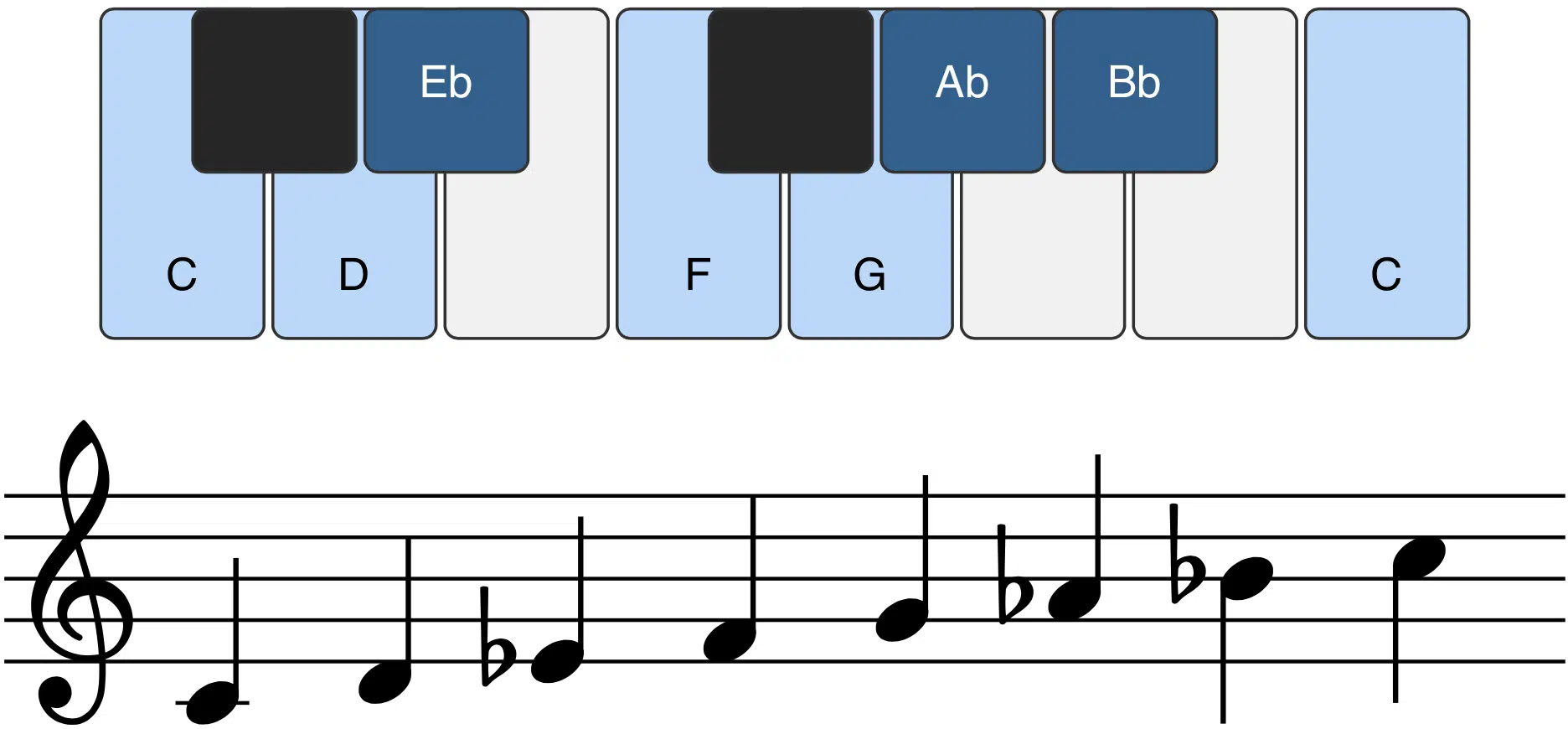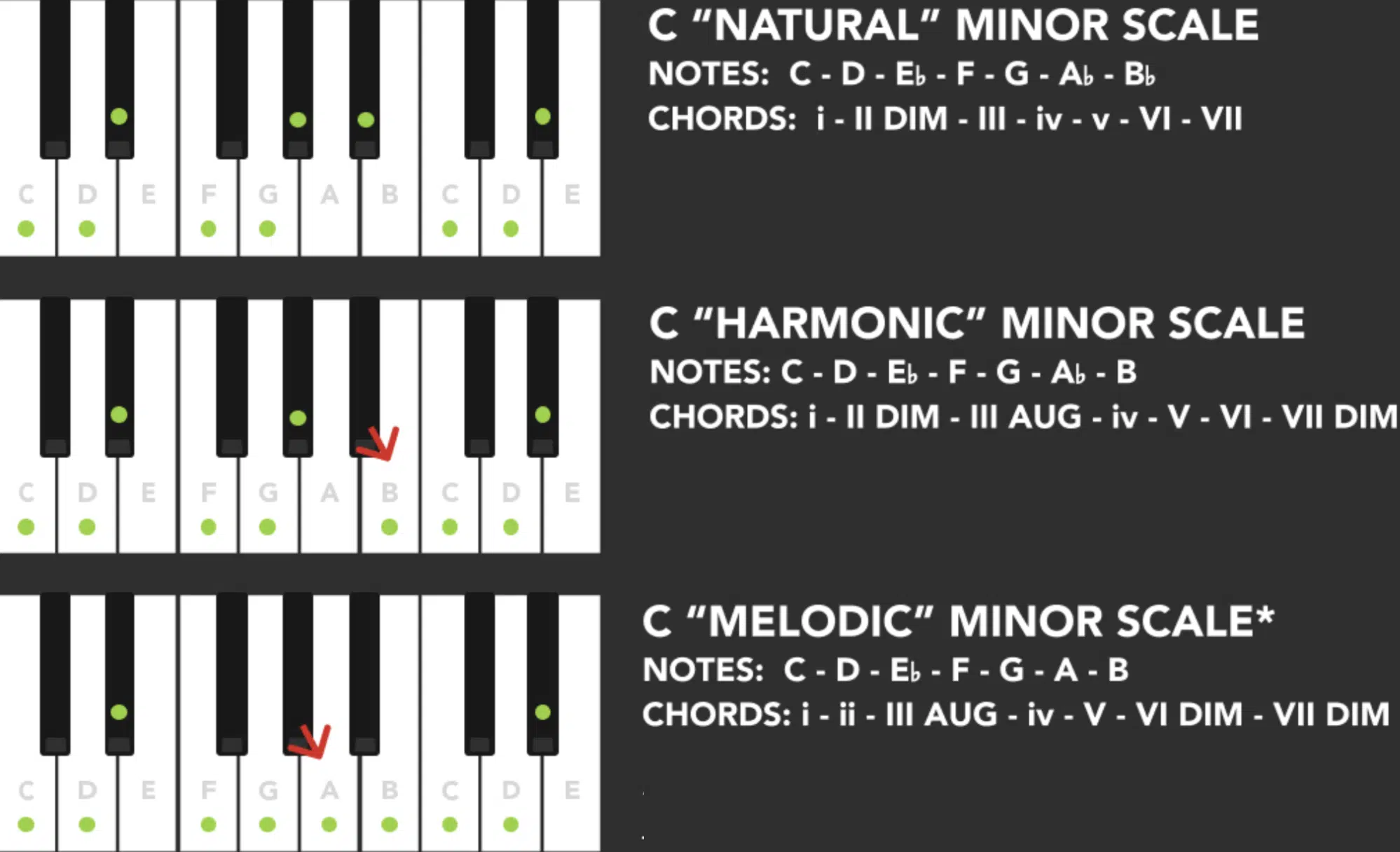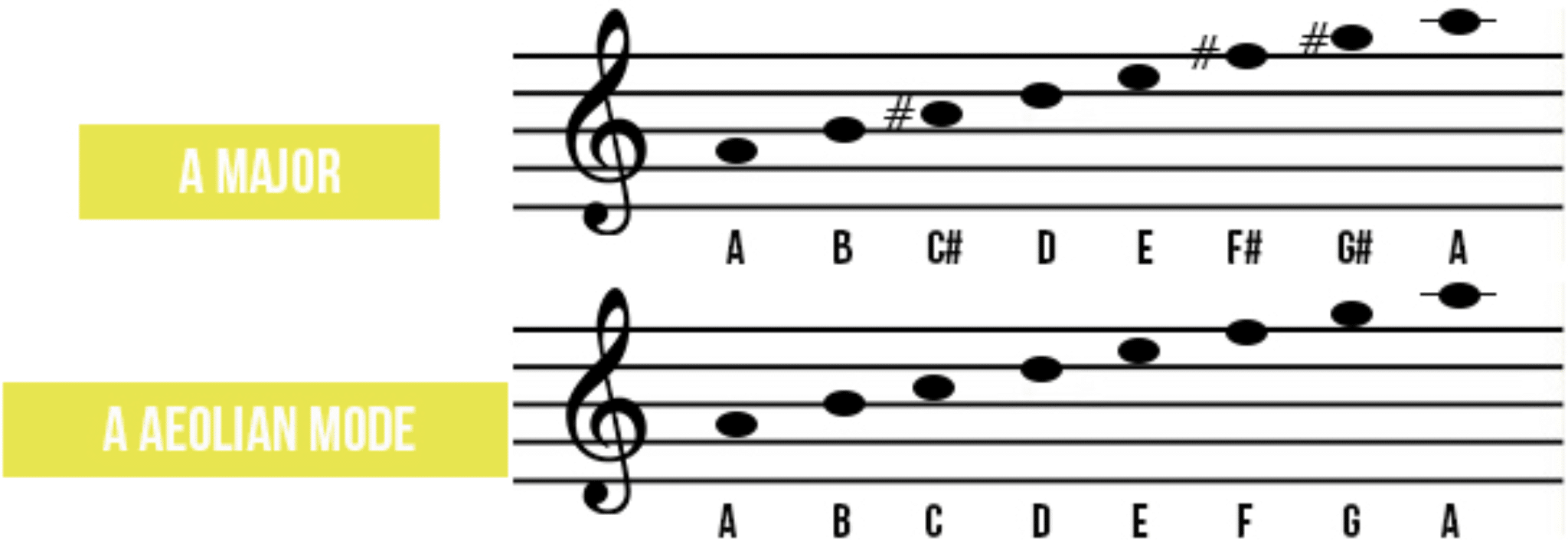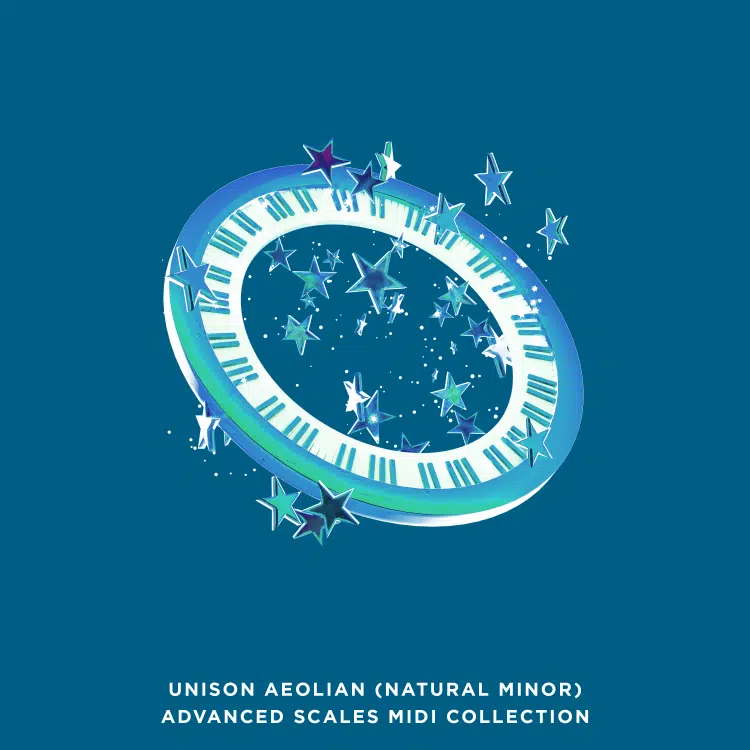The Aeolian scale is a musical key that radiates emotional depth and versatility.
It can infuse compositions with a rich, introspective mood and serve as a foundational element in various music genres.
The Aeolian scale offers a distinct sound that’s essential in creating dynamic, captivating, and impactful music.
So, as a music producer, it’s important to know all about it in order to unlock new creative potentials and enhance your musical expressions.
As well as diversify your overall compositional skills.
In this article, you’ll be exploring various aspects of the Aeolian scale, like:
- Understanding the Aeolian scale ✓
- Breaking down the Aeolian scale formula ✓
- Comparing Aeolian to other minor scales ✓
- Relationship of Aeolian with the major scale ✓
- Depth of the Aeolian mode ✓
- Practical applications in music production ✓
- Creative songwriting with the Aeolian scale ✓
- The role of intervals in Aeolian ✓
- Using Aeolian in different key signatures ✓
- Much more ✓
After this article, you’ll have a comprehensive understanding of the Aeolian scale.
You will be equipped to utilize its unique qualities in your compositions, create evocative melodies and harmonies, and experiment with it across various musical contexts.
Whether you’re crafting the next hit song or experimenting with new sounds, the insights gained here will elevate your music production skills.
So, let’s dive in…
Table of Contents
- What is the Aeolian Scale?
- Aeolian Scale Formula: Breaking it Down
- Comparing Aeolian to Other Minor Scales
- The Aeolian Scale’s Relation to the Major Scale
- The Aeolian Mode in Depth
- Practical Applications of the Aeolian Scale
- The Aeolian Scale in Songwriting
- The Role of Intervals in the Aeolian Scale
- Bonus: Unison Aeolian (Natural Minor) Advanced Scales MIDI Collection
- The Aeolian Scale: Final Thoughts
What is the Aeolian Scale?

The Aeolian scale, a term synonymous with the natural minor scale, is a cornerstone of modern music.
The Aeolian scale consists of a unique sequence of intervals, creating a sound that is both haunting and beautiful.
As a music producer, understanding the Aeolian scale is crucial for creating emotionally rich and sonically diverse tracks.
The Aeolian scale is often referred to as the sixth mode of the major scale, which means it shares the same notes as its parent major scale but starts on the sixth degree.
For instance, the A Aeolian scale is the sixth mode of the C major scale, consisting of the notes: A, B, C, D, E, F, and G.
This shared DNA with the major scale (the sixth mode) gives the Aeolian its distinct tonal quality.
Recognizing the Aeolian scale is more than just knowing the notes and note names 一 it’s about feeling the mood it conveys.
This scale, the sixth mode of the major scale, evokes a sense of melancholy and introspection, a trait that has made it a popular choice in various genres of music.
On the other hand, picture yourself in the Aeolian islands or its adjacent coastal district; it can evoke those joyful emotions too.
From classical compositions to modern pop songs, the Aeolian scale’s influence is undeniable and resonant.
Aeolian Scale Formula: Breaking it Down

Understanding the Aeolian scale formula is essential for any digital music producer.
The formula is straightforward: it is a sequence of whole and half steps in the order of: W, H, W, W, H, W, and W. (W=whole step, H=half step).
This pattern is what defines the Aeolian scale and sets it apart from other minor scales.
When exploring the Aeolian scale over one octave, the specific note names provide a unique identity to each tone, collectively called the natural minor scale due to their characteristic sound.
When we look at scales like A Aeolian (A B C D E F G) or E Aeolian (E F G A B C D), the pattern of intervals 一 whole and half steps 一 becomes clear.
It is crucial in understanding the scale’s structure.
To put this into perspective, let’s take the A Aeolian scale as an example… Starting from A, the scale progresses as follows:
- A to B (whole step; one tone)
- B to C (half step; one semitone)
- C to D (whole step)
- D to E (whole step)
- E to F (half step)
- F to G (whole step)
- G back to A (whole step)
This sequence of intervals is what gives the Aeolian scale its distinctive sound.
The beauty of the Aeolian scale formula lies in its simplicity and versatility.
The Aeolian scale formula can be transposed to any key, allowing for a wide range of emotional expressions in music.
Comparing Aeolian to Other Minor Scales

While the Aeolian scale is often used interchangeably with the term ‘natural minor scale,’ it’s important to differentiate it from other minor scales.
This includes the harmonic and melodic minor scales.
The Aeolian scale is unique due to its flat sixth and seventh degrees, which are not raised as in the harmonic and melodic minors.
This difference might seem subtle, but it has a significant impact on the scale’s character.
- The harmonic minor scale, with its raised seventh degree, creates a more tense and classical sound.
- The melodic minor scale, with both sixth and seventh degrees raised when ascending, offers a smoother, jazzier feel.
The Aeolian, with its consistent song structure, provides a more grounded and folk-like tone, which is very common amongst indie artists.
NOTE
Consider the C Aeolian scale (C D E♭ F G A♭ B♭) and compare it with the G Aeolian scale (G A B♭ C D E♭ F).
The difference in their tonal quality highlights the Aeolian scale’s versatility.
The Aeolian Scale’s Relation to the Major Scale

The relationship between the Aeolian scale and the Major scale is a fascinating aspect of music theory.
As the sixth mode of the major scale, the Aeolian shares the same notes but centers on a different root note (tonic note).
This connection, as it’s the sixth mode of the major scale, highlights the versatility and interconnectedness of scales in music composition.
For instance, the C major scale (C, D, E, F, G, A, B) and the A Aeolian scale (A, B, C, D, E, F, G) contain the same notes but evoke vastly different moods.
This duality of notes allows music producers and artists to shift the emotional tone of a piece simply by changing the focal point of the scale they are using.
This understanding is vital, as it opens up a realm of creative possibilities.
By mastering the relationships between the Aeolian scale and the major scale, you can move seamlessly between moods and modes.
The Aeolian Mode in Depth
The Aeolian mode is more than just the sixth mode of the major scale; it’s a gateway to musical expression and creativity. Let’s dive deeper into this popular mode and how it compares with other modes.
-
Aeolian Mode vs. Other Modes

The Aeolian mode stands out among other modes, such as the Dorian, Phrygian, Mixolydian, Ionian, or Locrian mode, due to its distinct tonal quality.
While all these modes originate from the major scale, the Aeolian mode, often called the natural minor scale, carries a unique emotional depth.
The Dorian mode, starting on the second degree of the major scale, has a jazzier, more upbeat feel compared to the often melancholic tone of the Aeolian.
The Phrygian mode, starting on the third degree, brings a more exotic and tense sound. This showcases how, when compared to the Aeolian mode, these different modes can dramatically alter the mood of a composition.
The Mixolydian mode, starting on the fifth degree of the major scale, also highlights the uniqueness of the Aeolian mode.
The Mixolydian mode, with its major third and flat seventh, has a bluesy, unresolved character.
This is quite different from the resolved and somber nature of the Aeolian mode.
Understanding these differences between the Aeolian mode and other modes is crucial, as it allows for more intentional and expressive use of modes in your beats.
Therefore, mastering the Aeolian mode can enhance your tracks significantly.
Practical Applications of the Aeolian Scale
Exploring the practical applications of the Aeolian scale reveals its versatility and impact in music production, so let’s dive in.
-
Incorporating the Aeolian Scale in Your Songs & Compositions

The Aeolian scale is a powerful tool for music producers looking to infuse their compositions with emotion and depth.
By utilizing the Aeolian mode, you can create melodies and chord progressions that resonate with listeners on a profound level.
The scale’s sequence of notes, especially when played on piano keys or visualized on a piano roll, offers a rich palette for crafting impactful musical pieces.
When songs in the Aeolian scale are written, it’s essential to focus on:
- Its characteristic intervals
- How they interact to produce the scale’s distinctive mood
Whether you’re composing for a minor key (minor keys) or integrating the Aeolian mode into a larger piece, its fluidity and expressiveness make it a favorite among producers.
Its application ranges from melancholic ballads to gripping electronic tracks 一 showcasing its adaptability in various musical contexts.
Pro Tip
The intervals in the B Aeolian scale (B C D E F♯ G A), particularly between C D E and E F♯ G, offer unique opportunities for creating tension and release in your compositions.
The Aeolian Scale in Songwriting
The Aeolian scale offers a wealth of opportunities for songwriting, providing a foundation for emotionally charged and memorable music.
-
Writing Melodies in the Aeolian Scale

Crafting melodies in the Aeolian scale is about more than just following a set of notes; it’s about telling a story that resonates with the listener.
The scale’s intervals bring a range of emotional tones to the table (from sorrowful to introspective) that can be used to shape the narrative of a song.
By focusing on how each note in the scale interacts with others, you can create melodies that are not only harmonically pleasing but also emotionally compelling.
Crafting melodies in keys like D Aeolian (D E F G A B♭ C) or B Aeolian (B C♯ D E F♯ G A) requires a deep understanding of how each note can evoke different emotions.
This is especially true when it comes to the E F G transition.
NOTE
A key aspect of writing melodies in the Aeolian mode is to emphasize its characteristic notes, such as:
- The lowered sixth degree
- The lowered seventh degree
These notes (the lowered sixth and seventh degrees) give the Aeolian its distinct sound and mood.
Experimenting with these intervals, perhaps starting or ending phrases on them, can bring out the unique qualities of the Aeolian scale in your melodies.
-
Creating Harmonic Progressions in Aeolian

Harmonic progressions in the Aeolian scale offer a tapestry of moods and textures to explore in songwriting.
The interplay of chords within the Aeolian mode can evoke a range of emotions 一 from introspective to contemplative.
For instance, a progression that moves from the tonic to the minor sixth and then to the minor seventh chords within the Aeolian scale can create a sense of longing or unresolved tension.
This is a hallmark of many memorable songs.
When designing a chord progression in the Aeolian mode, it’s beneficial to experiment with different:
- Combinations
- Sequences
This experimentation can lead to discovering unique sounds and atmospheres.
For example, juxtaposing the Aeolian scale’s chords with those from other modes, like the Mixolydian or Dorian, can add complexity and depth to your compositions.
The Role of Intervals in the Aeolian Scale

Intervals are the building blocks of the Aeolian scale, and understanding their role is key to mastering this mode.
Each interval in the Aeolian scale contributes to its overall mood and character.
For example, the half-step intervals, particularly between the second and third notes (B to C in the A Aeolian scale) and between the fifth and sixth notes (E to F in the same scale), impart a sense of melancholy that is characteristic of the Aeolian mode.
The intervals in the Aeolian scale also play a crucial role in creating tension and release within a musical piece.
The resolution from the seventh note back to the tonic, though subtle, provides a sense of completion and rest, pivotal in many compositions.
Understanding how these intervals interact and affect the overall dynamics of the scale is essential for utilizing the Aeolian mode effectively.
Plus, the intervals in the Aeolian scale can be manipulated to create variations and add interest to your compositions.
Altering certain intervals or emphasizing unexpected ones can give your music a distinctive edge.
This level of control over the intervals allows for creative freedom and expression.
Bonus: Unison Aeolian (Natural Minor) Advanced Scales MIDI Collection

Harness the power of the Aeolian mode with the Unison Aeolian (Natural Minor) Advanced Scales MIDI Collection.
It’s a revolutionary tool that enables you to instantly create over 1,100 Aeolian MIDI:
- Scales
- Chords
- Progressions
- Melodies
This collection is a goldmine for music producers 一 offering an extensive array of melodic elements in a flexible MIDI format.
Whether you’re a novice or a seasoned composer, this tool empowers you to infuse your tracks with the emotive depth and haunting beauty of the Aeolian scale, effortlessly.
The beauty of this MIDI collection lies in its adaptability and ease of use.
MIDI format offers unparalleled flexibility, allowing you to transpose and edit notes to suit your unique style and musical vision.
This means that you can take the foundational Aeolian elements provided and tailor them to create compositions that are distinctly yours.
It’s an invaluable resource for bypassing music theory, providing a perfect-sounding foundation for your tracks.
With this collection at your fingertips, you can quickly start and finish compositions, find instant inspiration in new scales, chords, and progressions.
As well as elevate your music to stand out in the competitive world of modern music production.
The Aeolian Scale: Final Thoughts
From its fundamental structure and relation to other scales and modes, to practical applications in songwriting, the Aeolian scale is invaluable.
Whether you’re just starting out or are an experienced producer, the insights and resources discussed here, offer invaluable assistance in your musical creations.
Armed with this knowledge and these tools, you’re now equipped to harness the full potential of the Aeolian scale.
Therefore, you will be able to create tracks that not only resonate deeply with your audience but also highlight your unique style.
So embrace this scale’s versatility, explore its emotional depths, and let it inspire your next musical masterpiece.
Until next time…







Leave a Reply
You must belogged in to post a comment.